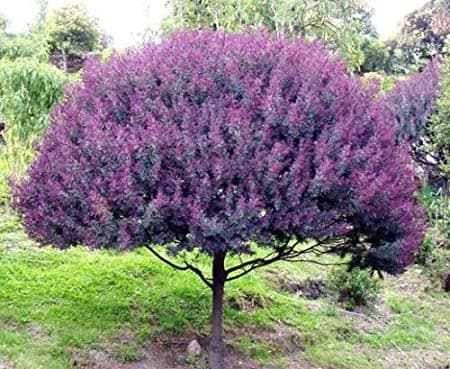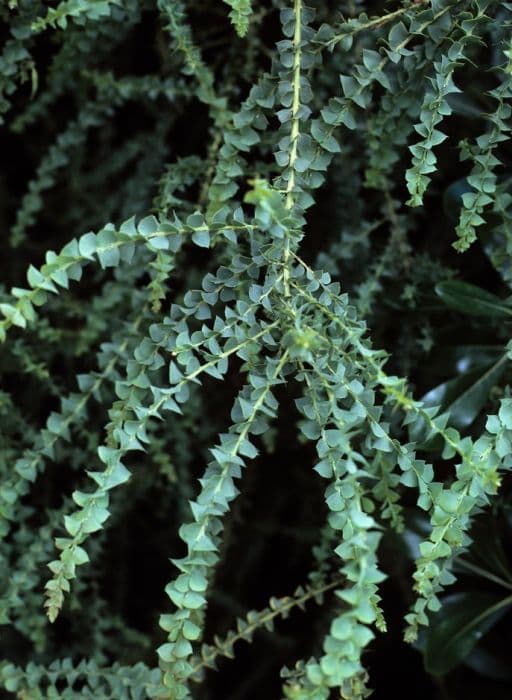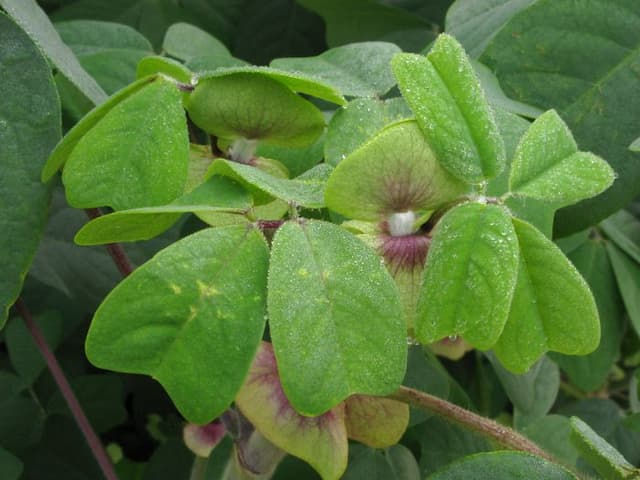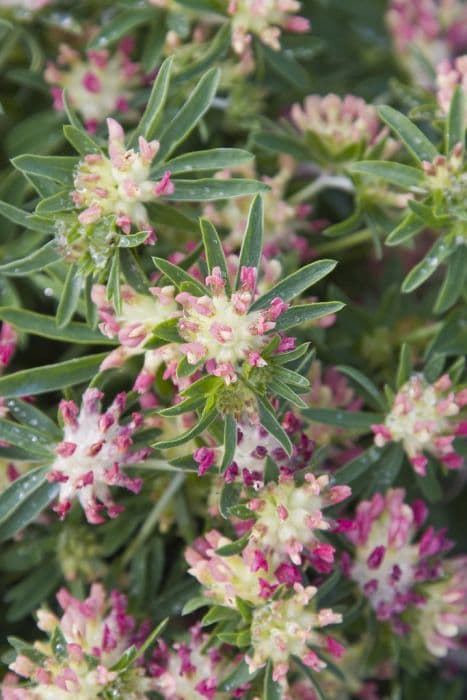Sweet pea Lathyrus odoratus 'Jayne Amanda'

ABOUT
The Lathyrus odoratus 'Jayne Amanda', commonly known as sweet pea, is a captivating flowering plant known for its beautiful and vividly colored blooms. This variety typically produces flowers that are a breathtaking blend of pinks and purples, exhibiting a gradient of shades that can range from soft pastels to deeper, more saturated tones. The petals have a delicate and almost silky appearance, with a classic sweet pea shape that includes a standard, wings, and a keel, creating a charming, butterfly-like look. These flowers are not only visually appealing but are also admired for their delightful fragrance, which can be quite powerful and contribute to their popularity for use in gardens and floral arrangements. The blossoms are typically arranged in clusters on slender, green stems that are adorned with tendrils. These tendrils allow the plant to climb and provide support when grown alongside structures like trellises or fences. The foliage of sweet pea 'Jayne Amanda' consists of small, pale green leaves that are pinnate in form, meaning they are arranged in pairs along the stem. The overall appearance of the plant is one of delicate beauty, with the soft foliage providing a gentle backdrop to the striking, fragrant flowers that have made the sweet pea a beloved addition to many gardens.
About this plant
 Names
NamesFamily
Fabaceae.
Synonyms
Sweet Pea, Everlasting Pea, Perennial Pea, Lathyrus.
Common names
Lathyrus odoratus.
 Toxicity
ToxicityTo humans
The plant commonly known as sweet pea (Lathyrus odoratus) does contain toxic elements, particularly in the seeds and seed pods. If ingested in large quantities, these can cause a condition known as lathyrism. Lathyrism can result in symptoms such as weakness, lethargy, paralysis of the legs, and potentially may lead to permanent neurologic damage if consumption is not addressed quickly and appropriately. Care should be taken to ensure that children do not consume the seeds or seed pods of the sweet pea plant.
To pets
Sweet pea (Lathyrus odoratus), while attractive, can be toxic to pets if they ingest parts of the plant, particularly the seeds and seed pods. Symptoms of poisoning in pets may include vomiting, diarrhea, lethargy, tremors, seizures, and more severe cases could potentially lead to neurological problems or even death if left untreated. Pet owners should prevent pets from having access to sweet peas and should consult a veterinarian immediately if they suspect their pet has ingested this plant.
 Characteristics
CharacteristicsLife cycle
Annuals
Foliage type
Deciduous
Color of leaves
Green
Flower color
Varies
Height
6 feet (1.8 meters)
Spread
1 foot (0.3 meters)
Plant type
Climber
Hardiness zones
2
Native area
Mediterranean
Benefits
 General Benefits
General Benefits- Aesthetic Appeal: Lathyrus odoratus 'Jayne Amanda', commonly known as sweet pea, produces beautiful and vibrant flowers that can enhance the visual beauty of gardens and landscapes.
- Fragrance: The sweet pea is well-known for its delightful and strong fragrance, which can perfume an entire garden area.
- Attracts Pollinators: Sweet peas are attractive to bees, butterflies, and other beneficial pollinators, promoting biodiversity in the garden.
- Climbing Growth Habit: As a climbing plant, sweet pea can be used to decorate trellises, fences, and other vertical structures, adding dimension to garden design.
- Easy to Grow: Sweet peas are generally easy to cultivate, making them suitable for gardeners of all skill levels, from beginners to experts.
- Variety of Colors: They come in a wide range of colors, offering versatility for color-themed gardens and floral arrangements.
- Cut Flowers: With their long stems and attractive blooms, sweet peas are excellent for cutting and creating bouquets or indoor flower arrangements.
- Seasonal Interest: Sweet peas have a specific blooming season in spring and early summer, providing a distinct time of interest and color in the garden.
- Educational Value: Gardening with sweet peas can be a learning experience, teaching about plant growth, pollination, and horticultural techniques.
- Cultural Significance: Sweet peas have been cultivated for centuries and have a rich history in horticulture, offering cultural and historical value to enthusiasts.
 Medical Properties
Medical PropertiesThis plant is not used for medical purposes.
 Air-purifying Qualities
Air-purifying QualitiesThis plant is not specifically known for air purifying qualities.
 Other Uses
Other Uses- Sweet pea pods are sometimes used in compost as a nitrogen-rich material to help break down organic waste more efficiently.
- The stems of sweet pea plants can be woven to create biodegradable garden trellises, providing a natural support for other climbing plants as well.
- Dried and crushed sweet pea flowers are occasionally added to homemade potpourri mixtures due to their pleasant fragrance.
- Sweet pea seeds, once thoroughly dried and hardened, can be used in craft projects, such as making seed mosaics or jewelry items.
- The long, flexible tendrils of sweet pea plants are sometimes utilized in the art of flower arrangement as a way to add delicate, whimsical curves to bouquets.
- Infusions made from sweet pea flowers are used to add natural scents to homemade soaps, though care is taken due to potential toxicity.
- Farmers can plant sweet peas as a cover crop in the off-season to help fix nitrogen in the soil and prevent erosion.
- The brightly colored flowers of sweet peas can be used to create natural dyes for textiles or art projects, generating a range of hues depending on the mordant used.
- Sweet pea petals have been traditionally used to decorate wedding or celebration cakes, although they are not eaten due to toxicity concerns.
- The plant’s vines may be used as a green backdrop in pet enclosures, as long as there is no risk of ingestion by the animals.
Interesting Facts
 Feng Shui
Feng ShuiThe Sweet Pea is not used in Feng Shui practice.
 Zodiac Sign Compitability
Zodiac Sign CompitabilityThe Sweet Pea is not used in astrology practice.
 Plant Symbolism
Plant Symbolism- Pleasure: Sweet peas, including Lathyrus odoratus 'Jayne Amanda', are often associated with pleasure and blissful enjoyment, alluding to the sweet fragrance and delicate appearance of their flowers.
- Goodbye or Departure: Giving sweet peas can symbolize a farewell or goodbye, making them a fitting gift when someone is leaving or moving on to another phase of life.
- Thankfulness: The sweet pea can be a symbol of gratitude, representing thankfulness for a lovely time or for the kindness that someone has shown.
- Delicate Pleasures: Due to their exquisite and fragrant blooms, sweet peas symbolize the delicate pleasures that bring joy to our senses and remind us to appreciate the small beauties in life.
 Water
WaterSweet peas should be watered deeply to encourage a strong root system, typically receiving about 1 inch of water per week. During hotter, drier periods, you may need to water your 'Jayne Amanda' sweet peas twice a week. Ensure that the soil is kept consistently moist but not waterlogged, as too much water can lead to root rot. A good rule of thumb is to check the soil before watering; if the top inch feels dry to the touch, it's time to water. It's best to water in the morning to allow foliage to dry out during the day and to use approximately 4 gallons of water per square yard per week, adjusting based on rainfall and temperature.
 Light
LightSweet peas, including the 'Jayne Amanda' variety, thrive in full sunlight with at least six hours of direct daylight daily, which promotes strong growth and optimal flowering. An ideal spot would be an area that receives morning sun and some protection from the intense heat of the late afternoon sun in hot climates. However, in cooler climates, a sunny spot that gets light throughout the day is preferred to keep 'Jayne Amanda' sweet peas happy and healthy.
 Temperature
TemperatureSweet peas, such as 'Jayne Amanda', prefer cooler temperatures and thrive in conditions where daytime temperatures are between 55°F and 65°F. They can tolerate a minimum temperature of 25°F but risk damage with prolonged exposure to frost. Ideally, night temperatures should stay above 40°F for optimal growth. These plants will start to languish when temperatures consistently rise above 75°F, so they are best suited for the cooler parts of the growing season.
 Pruning
PruningPruning sweet peas, including 'Jayne Amanda', is essential to promote continuous blooming and maintain a tidy appearance. Deadhead spent flowers regularly to encourage new growth and prevent seed formation, which can halt further blooming. Lightly prune or pinch out growing tips when plants are 6 inches tall to encourage bushier growth. The best time for heavier pruning is in late winter or early spring before the new growth begins in earnest.
 Cleaning
CleaningAs needed
 Soil
SoilSweet pea prefers well-drained, fertile soil with a pH between 6.0 and 7.5. A good mix can be made with equal parts of loamy garden soil, compost, and a handful of granular organic fertilizer to promote strong growth. Adequate drainage is essential to prevent root rot.
 Repotting
RepottingSweet peas are annuals and do not typically require repotting. They are sown directly where they are to flower, as they do not transplant well due to their delicate root system. After their growing season, they can be replaced with new plants.
 Humidity & Misting
Humidity & MistingSweet peas prefer moderate humidity levels. They do not require unusually high humidity environments but should not be placed in excessively dry conditions either. Natural outdoor humidity is generally suitable for these plants.
 Suitable locations
Suitable locationsIndoor
Ensure bright light, cool temps, and regular watering.
Outdoor
Plant in sun, enrich soil, water regularly, protect from wind.
Hardiness zone
2-11 USDA
 Life cycle
Life cycleSweet Pea 'Jayne Amanda' begins its life cycle as a seed, which germinates when soil temperatures are between 55 to 65 degrees Fahrenheit and after being soaked in water to soften the hard outer shell. Upon germination, the seedling emerges, developing its first true leaves and rapidly growing a vine that seeks support to climb. As it matures, the vine develops tendrils that allow it to cling to supports, facilitating its vertical growth. The plant enters a flowering stage, producing fragrant and colorful blossoms that attract pollinators, leading to pollination and subsequent seed formation. After flowering, seed pods form and mature on the vine, eventually drying and releasing seeds for future plantings. The plant is an annual, completing its life cycle within one growing season, after which it dies, relying on the dispersed seeds to propagate the next generation.
 Propogation
PropogationPropogation time
Spring
Lathyrus odoratus 'Jayne Amanda', commonly known as Sweet Pea 'Jayne Amanda', is most popularly propagated through seeds. The best time for seed sowing is either in late October to November or from January to March, depending on the climate. To propagate, soak the seeds in water for 24 hours to soften the seed coat, which enhances germination rates. Then sow seeds about 1 inch deep in well-draining soil containers or directly in the garden where the plants are to grow. Ensure the soil is kept moist but not waterlogged until germination, which usually occurs within 7 to 15 days, depending on the temperature. Sweet Peas prefer a sunny location and need support for climbing, so it is advisable to provide a trellis or support structure at the time of planting. This method is straightforward and usually results in vibrant and fragrant blooms characteristic of the 'Jayne Amanda' variety.









